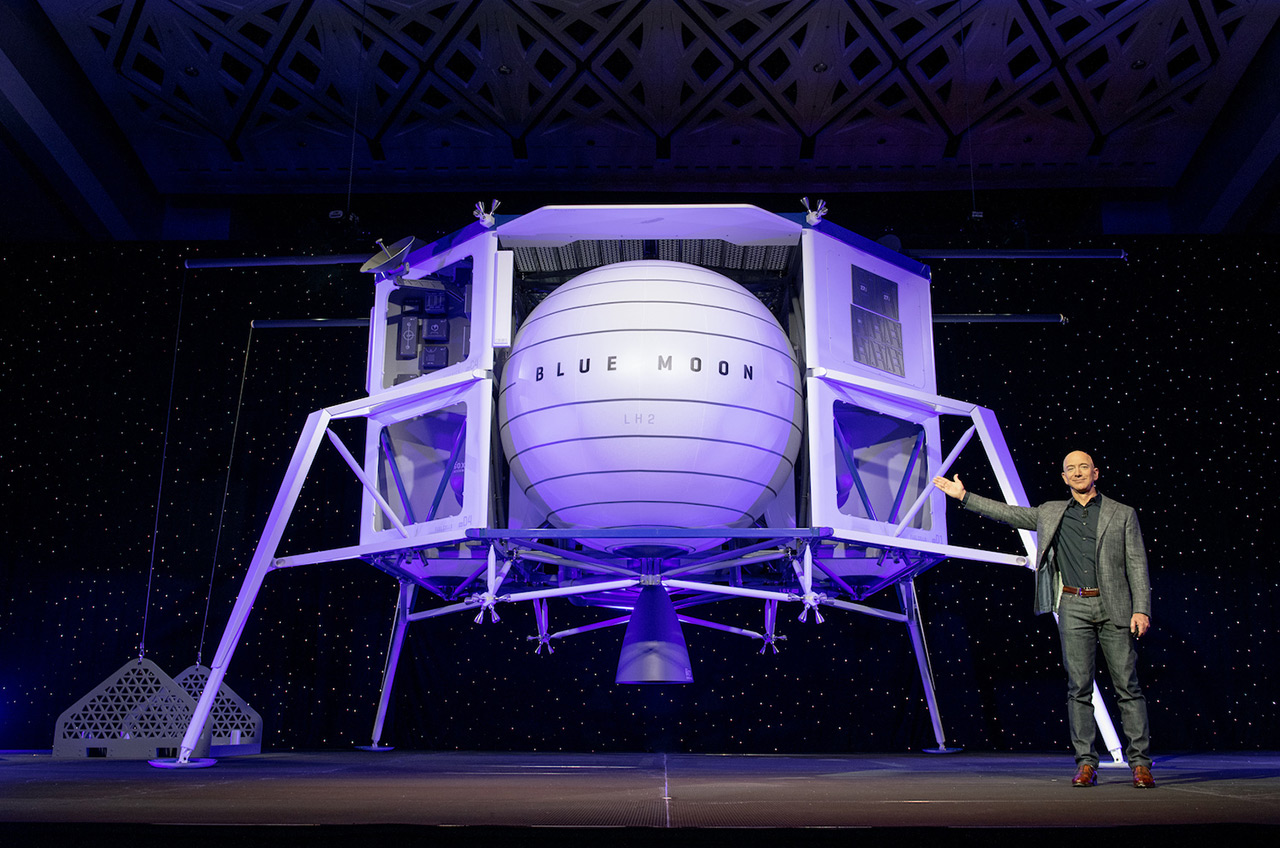Jeff Bezos Unveils Blue Origin's Dream Team to Land NASA Astronauts on the Moon
Draper, Lockheed Martin and Northrop Grumman join the team.

WASHINGTON — Blue Origin founder Jeff Bezos on Tuesday (Oct. 22) unveiled a "national team" for his company's plan to land astronauts on the moon for NASA's Artemis program, with three veteran aerospace companies joining the project.
The U.S. companies Draper, Lockheed Martin and Northrop Grumman will join Blue Origin's bid to build a crewed lunar lander for Artemis, NASA's project to return astronauts to the moon by 2024, Bezos said.
"We could not ask for better partners," Bezos told a crowd here at the 70th International Astronautical Congress. "This is a national team for a national priority."
Related: Blue Origin's Blue Moon Lander: A Photo Tour
Blue Origin's crewed moon lander project follows a NASA call for proposals last month, opening the door to commercial lunar lander ideas for Artemis astronauts.
According to Bezos, Blue Origin will lead its lunar lander team and provide the Descent Element that will ultimately carry a crew to the moon's surface. The descent stage will use the company's new BE-7 engine and a design derived from the robotic Blue Moon lander Bezos unveiled earlier this year.
Lockheed Martin will build a reusable Ascent Element, which will house the astronauts and return them to lunar orbit once their surface work is complete. The company, which is also building NASA's Orion crew capsule, will oversee Blue Origin crew flight operations and training.
Get the Space.com Newsletter
Breaking space news, the latest updates on rocket launches, skywatching events and more!
Bezos touted Lockheed Martin's expertise at landing on Mars and long experience with crewed life support systems. "They are experts in life support systems and so to have their expertise on the Ascent Element is a really big deal," he said."
Northrop Grumman will provide a Transfer Element for the lunar lander, bringing it near the moon before the lander separates to make the final descent. That company built NASA's original Lunar Module for the Apollo program, Bezos reminded the crowd.
Draper, meanwhile, will design the guidance and navigation systems that will guide the lander to the moon. It's something Draper has done before for NASA's Apollo program, but the process has evolved with new technologies.
“We guided Apollo to the moon and back nearly 50 years ago," Draper President and CEO Kaigham Gabriel said in a statement. "We're ready to do it again with the Blue Origin team for Artemis."
In his remarks here, Bezos hailed Blue Origin's partners as essential of NASA is going to fly astronauts to the moon in the next five years.
"This is the kind of thing that's so ambitious, it needs to be done with partners," Bezos said. "This is the only way to get back to the moon fast."
In addition to Artemis moon lander partner announcement, Bezos offered a few clues on Blue Origin's space plans in the months and years to come.
The company is testing its suborbital New Shepard spacecraft for space tourist flights, which could begin in 2020, and is also developing a massive reusable rocket, called New Glenn, that is scheduled to make its debut in two years.
"New Glenn will fly in 2021," Bezos said. He did not mention a target for crewed flights on New Shepard.
Blue Origin is building its New Glenn rocket at the company's factory in Cape Canaveral, Florida so it will be closer to its launch site at the nearby Cape Canaveral Air Force Station, Bezos said. It will have a payload fairing that will offer twice the volume than any other booster on the market and
Much of the advancements for New Glenn stem from Blue Origin's experiences developing its New Shepard suborbital rocket and spacecraft. The company has launched 11 New Shepard missions since 2016, reusing its capsules multiple times. The most recent flight, called NS-11, launched (and landed) in May at Blue Origin's West Texas proving grounds.
"Everything is better when you do a version two," Bezos said. "New Glenn is version two."
- Lunar Base and Gateway Part of Sustainable Human Exploration Plan
- Lockheed Martin Proposes 'Early Gateway' to Put Astronauts on the Moon
- Elon Musk Jabs Jeff Bezos Over Blue Origin's Moon Lander
Email Tariq Malik at tmalik@space.com or follow him @tariqjmalik. Follow us on Twitter @Spacedotcom and on Facebook.
Join our Space Forums to keep talking space on the latest missions, night sky and more! And if you have a news tip, correction or comment, let us know at: community@space.com.

Tariq is the Editor-in-Chief of Space.com and joined the team in 2001, first as an intern and staff writer, and later as an editor. He covers human spaceflight, exploration and space science, as well as skywatching and entertainment. He became Space.com's Managing Editor in 2009 and Editor-in-Chief in 2019. Before joining Space.com, Tariq was a staff reporter for The Los Angeles Times covering education and city beats in La Habra, Fullerton and Huntington Beach. In October 2022, Tariq received the Harry Kolcum Award for excellence in space reporting from the National Space Club Florida Committee. He is also an Eagle Scout (yes, he has the Space Exploration merit badge) and went to Space Camp four times as a kid and a fifth time as an adult. He has journalism degrees from the University of Southern California and New York University. You can find Tariq at Space.com and as the co-host to the This Week In Space podcast with space historian Rod Pyle on the TWiT network. To see his latest project, you can follow Tariq on Twitter @tariqjmalik.









